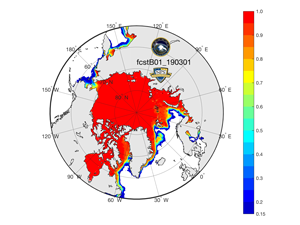Regional Arctic System Model (RASM) - Regional Arctic System Model (RASM)
About the Regional Arctic System Model (RASM)
The Regional Arctic System Model (RASM) has been developed to advance capability in simulating critical physical processes, feedbacks and their impact on the Arctic climate system and to reduce uncertainty in its prediction. RASM is a limited-area, fully coupled ice-ocean-atmosphere-land model that uses the Community Earth System Model (CESM) framework. It includes the Weather Research and Forecasting (WRF) model, the LANL Parallel Ocean Program (POP) and Community Ice Model (CICE) and the Variable Infiltration Capacity (VIC) land hydrology model. In addition, a streamflow routing (RVIC) model was recently implemented in RASM to transport the freshwater flux from the land surface to the Arctic Ocean. Finally, marine biogeochemistry components are currently being implemented in the ocean and sea ice components to expand RASM capability into Arctic ecosystem studies. The model domain is configured at horizontal resolution of 1/12° (or ~9km) for the ice-ocean and 50 km for the atmosphere-land model components. It covers the entire Northern Hemisphere marine cryosphere, terrestrial drainage to the Arctic Ocean and its major inflow and outflow pathways, with optimal extension into the North Pacific / Atlantic to model the passage of cyclones into the Arctic. All RASM components are coupled at high frequency to realistically represent interactions among model components at inertial and longer time scales. For more information about this project, see Project Overview (PDF).
Predictions

Arctic sea ice is a sensitive indicator of the state of Arctic climate and its polar amplification. However, the causes of Arctic ice melt and its rate are not fully understood. Global climate models (GCMs) vary widely in their predictions of warming and the rate of Arctic ice melt, suggesting it may take anywhere from a couple of decades to more than a century to melt most of the summer sea ice cover. The multi- model average forecast based on results from the Intergovernmental Panel for Climate Change Fourth Assessment Report (IPCC-AR4) predicts a 50% reduction of summer sea ice in the Arctic Ocean by the end of this century. Unfortunately, the majority of those models have significant limitations in their representation of past and present sea ice variability in the Arctic. Some of the critical limitations include: sea ice thickness distribution, deformation, variability and export, air-ice-sea interactions, northward oceanic/atmospheric heat convergence, and freshwater export. This proposal intends to target potential causes of those limitations associated with resolution and sophistication of ocean-atmosphere boundary layers and their interaction with and without the sea ice cover. The recently developed high-resolution Regional Arctic System Model (RASM) will be used as a tool for numerical simulation and synthesis with in-situ and satellite observations to investigate the critical physical feedback processes and interactions between the atmosphere, ocean, and land under a diminishing sea ice cover. View the Interactive Predictions Model.

RASM is a limited-area, fully coupled ice-ocean-atmosphere-land model that uses the Community Earth System Model (CESM) framework.

